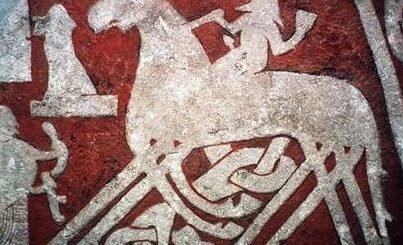The Sons of Ivaldi in Norse Mythology

Sons of Ivaldi were believed to have crafted many of the precious objects in Norse mythology, including Sif’s golden hair and Odin’s spear Gungnir |Image: Elmer Boyd Smith (1902).
Famous for forging a number of very precious artifacts in Norse mythology, the Sons of Ivaldi were master dwarfs skilled in a host of crafts work, including forging. Much of the myths about the sons of Ivaldi come from the Prose Edda, more specifically the Skáldskaparmál, the second part of the Prose Edda. The Prose Edda refers to an early 13th century textbook about Norse myths and stories. It is often held that the Icelandic historian and legislator Snorri Sturlusson was the one who authored the Prose Edda.
It remains unclear as to the dwarfs that constituted the Sons of Ivaldi. Neither is the Prose Edda clear on the number of Ivaldi’s sons. What is very clear is the objects that those skilled dwarfs made.
The article below explores the objects that were created by the Sons of Ivaldi in Norse mythology.
Odin’s Spear – Gungnir
Gungnir – Odin’s powerful spear – is known in Norse mythology as the “swaying one”. The name of the spear was also said to have been derived from the word “gungre”, which means “to tremble” in Old Danish.
The poem Skáldskaparmál (in the Prose Edda) states that Gungnir was forged by a dwarf called Dvalin, who was also one of the Sons of Ivaldi.
In the Poetic Edda, the trickster god Loki was the one who facilitated the acquisition of Gungnir from the dwarfs. Loki was able to acquire the powerful spear while on an important quest to the land of the dwarfs.
According to the poem Völuspá in the Poetic Edda, the legendary Aesir-Vanir War – a war between Norse fertility deities and the Aesir gods – is said to have started when Odin hurled Gungnir across a room of Vanir gods.
In the myths, Gungnir is perhaps the most balanced weapon in the gods’ arsenal as it always strikes its target irrespective of the proficiency of the person wielding it. Odin is destined to ride into Ragnarok wearing a gold helmet and wielding Gungnir as he leads the Einherjar – deceased soldiers that eat and dine in the hall of Valhalla. Odin also uses Gungnir to wrestle fiercely with the mighty wolf Fenrir.
Skidbladnir – the god Freyr’s ship

Dubbed the best of ships, Skidbladnir was believed to have been made by the Sons of Ivaldi after Loki used his wits and charm to convince them to make Sif’s golden hair and Odin’s spear Gungnir | The bottom right corner shows the ship Skíðblaðnir and Sif’s golden hair.
Skíðblaðnir or Skidbladnir is said to be the best and most robust ship in Norse mythology. Made by the dwarfs for Freyr, the god of harvest, peace and prosperity, Skíðblaðnir could be shrunk and fitted into one’s bag or pocket. It was also said that the magic in Skidbladnir allowed it to always get fair winds whenever the sails were raised. The ship was also believed to have the ability to travel anywhere.
Both the Poetic Edda and the Prose Edda make mention of the ship. For example, in the Poetic Edda, it is revealed that even though the Skidbladnir is not the largest ship, it has enough room to accommodate all the Norse gods as well as their weapons.
Being the owner of Skidbladnir, the god Freyr was also known as the “possessor of skidbladnir”. The honor of largest ship belongs to Naglfar, a boat made from the toenails and fignernails of the dead.
Heimskringla – a 13th century compilation of stories about Old Norse kings – states that the ship derived its abilities from a spell cast by Odin, the all-father god in Norse mythology. In this account, Odin is the one who owns the Skidbladnir.

Loki, the master of deceit, cutting off the goddess Sif’s hair | Image by Willy Pogany (1920)
Sif’s golden hair
Although she was an earth goddess, the goddess Sif in Norse mythology is most known for her golden hair. Prior to acquiring her beautiful golden hair, Sif, the wife of the thunder god Thor, had an ordinary hair. However, it was cut off by Loki, the trickster god, as stated in the poem Skáldskaparmál. To atone for his mischief, Loki made a trip to the dwarfs, imploring them to make a golden hair for Sif.

The goddess Sif is described Norse mythology as the loveliest of women. The fair-haired deity was also the wife of the thunder god Thor | Image: The goddess Sif holds her long, golden hair while grain grows behind her in an illustration from 1897




























I don’t know if The Sons of Ivaldi are any relation to me. My last name is Evaldi. My Dad said when my Great Grandfather came over to America in the early 1900’s the last name was changed from Ivaldi to Evaldi. So it may be in the tribe I don’t know.